The Immigrant Legal Resource Center (ILRC) immigration attorneys’ expertise focuses on family-based immigration, humanitarian relief, naturalization and citizenship, immigration enforcement, and removal defense.
Since 1979 we have helped expand the immigration expertise of attorneys, nonprofit staff, criminal defenders, and others assisting immigrant clients.
In addition to authoring the ILRC’s practice manuals, our expert attorneys have been published by Continuing Education of the Bar (CEB), American Immigration Lawyers Association (AILA), ILW.com, Huffington Post, Sargent Shriver National Center on Poverty Law, Center for Law and Social Policy, The Hill, LexisNexis Emerging Issues, and Fox News Latino.
We have also provided training to National Council of Juvenile and Family Court Judges, National Association of Criminal Defense Lawyers, American Immigration Lawyers Association (AILA), American Bar Association Commission on Immigration, Federal Bar Association, The State Bar of California, Legal Aid Association of California, Judicial Council of California and more.
<p><strong>Now available and updated for 2013!</strong> The Case Update to the <em>Defending Immigrants in the Ninth Circuit: Impact of Crimes under California and Other State Laws</em>. The PDF provides the 2013 update only to the 10th Edition, and does not include the full book.</p><p>Criminal defense attorneys who represent noncitizens and immigration attorneys alike have long relied on ILRC’s expertise and resources in defense of noncitizens in criminal and immigration proceedings. The all-new 2013 Case Update shows step-by-step how to identify, analyze and defend against the adverse immigration consequences of charges, using a combination of user-friendly charts, summaries and practice aids, and in-depth discussion of defense strategies. It also includes extensive discussion of California offenses, including new defense strategies for assault, domestic violence, drugs, sexual crimes with minors and other commonly charged offenses. A key section describes new strategies for how to control the record of conviction in pleas to "divisible" statutes in light of the Ninth Circuit decision in Young v. Holder. This Case Update provides requirements for immigration applications (asylum, cancellation, etc.) and post-conviction relief.</p>
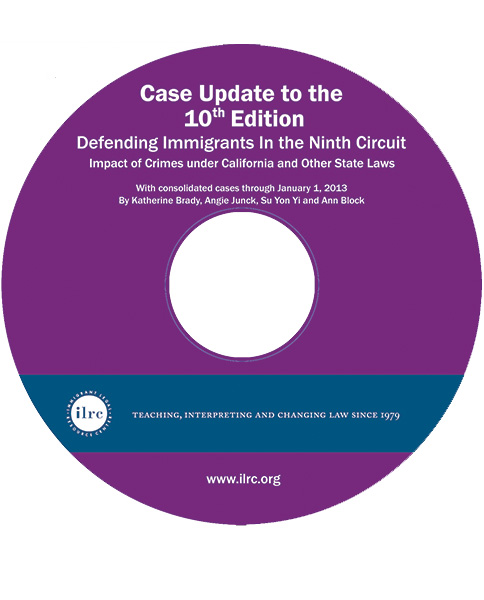
<p><strong>Completely updated in 2014.</strong> <em>A Guide for Immigration Advocates</em> is a practical and essential tool for beginning immigration attorneys, immigration law firms employing paralegals, BIA accredited representatives, and nonprofit community-based organizations. The <em>Guide</em> is unique among immigration law manuals because it provides a comprehensive detailed overview of the law that is both practical and easy to use. More than a compilation of immigration law topic articles, it’s a how-to manual containing clearly worded explanations of each subject and includes sample applications, charts, and examples to illustrate the concepts. This invaluable resource also provides practical advice on working with your clients to elicit the information you need to assist them efficiently and accurately.</p><p><em>A Guide for Immigration Advocates</em> is a two-volume, practical guide for advocates to use in their everyday practice. In addition to substantive law, each chapter includes information on critical books for your library, internet research, systems for identifying the potential remedies in a case, and how to manage a caseload. This book is a real time-saver for attorneys and paralegals, whether working for a community organization or in private practice!</p><p><strong>New and Updated Sections</strong></p><p>We've added several new sections in this edition:</p><ul><li>Deferred Action for Childhood Arrivals (DACA)</li><li>Provisional Waivers</li><li>Defense of Marriage Act (DOMA)</li><li>Same-Sex Spouses</li><li>Asylum Clock</li><li>New Consequences of DUIs in Removal Cases</li></ul>

<p>Criminal defense attorneys who represent noncitizens and immigration attorneys alike have long relied on ILRC’s expertise and resources in defense of noncitizens in criminal and immigration proceedings. This manual shows step-by-step how to identify, analyze and defend against the adverse immigration consequences of charges, using a combination of user-friendly charts, summaries and practice aids, and in-depth discussion of defense strategies. It includes extensive discussion of California offenses, including new defense strategies for assault, domestic violence, drugs, sexual crimes with minors and other commonly charged offenses. A key section describes new strategies for how to control the record of conviction in pleas to "divisible" statutes. The book includes chapters on defense of juveniles, requirements for immigration applications (asylum, cancellation, etc.), immigration detainers and detention, and post-conviction relief.</p><p>If you already own the 10th Edition of the manual, you can find the <a href="/publications/2013-case-update-for-defending-immigrants-in-the-ninth-circuit"><em>2013 Consolidated Case Update</em> here</a>.</p>
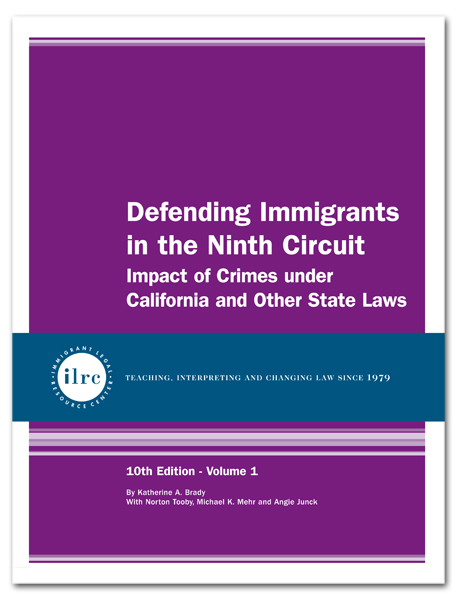
<p style="text-align: center;"><strong>Learn more in <a href="/families-immigration-practical-guide-4th-edition" target="_blank">this video</a>.</strong></p><p><em><strong>Families & Immigration: A Practical Guide</strong></em> is an essential tool for practitioners who assist in all aspects of family-sponsored immigration. This single volume resource is designed for everyday practice by new and seasoned immigration attorneys, immigration paralegals, community-based organizations or family immigration advocates.</p><p>This guide provides a comprehensive overview of family immigration law with clearly worded explanations, samples and charts. It reaches all aspects of family-sponsored immigration, including a thorough examination of issues related to immigration through marriage. Both the legal requirements and procedural instructions are covered in detail. This tool is intended to guide you step-by-step through the process of filing a family-based visa petition, an adjustment of status, immigrant visa application or any other related form or application. You will find a comprehensive discussion of each of the following topics:</p><ul><li>Affidavit of support</li><li>Adjustment of status</li><li>Consular processing</li><li>Child Status Protection Act</li><li>Conditional residence and the Petition to Remove the Conditions of Residence, including the corresponding waivers</li><li>Grounds and waivers of inadmissibility, including the new Provisional Unlawful Presence Waiver</li><li>Petition for Alien Relative</li><li>V and K visas</li></ul><p><em>Families & Immigration: A Practical Guide</em> also walks readers through the Violence Against Women Act and explains the self-petitioning process for immigrant victims of domestic violence. The guide presents alternate immigration remedies that are available for victims of domestic violence.</p>
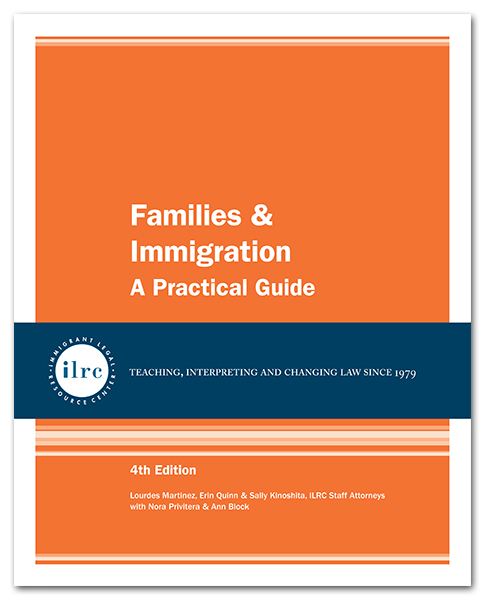
<p>This manual continues to be one of ILRC’s best-selling resources because it contains a unique combination of legal analysis and practice. This manual describes in detail the different standards applicable in hardship law, as well as the factors involved in that analysis; and it demonstrates how to work with clients to elicit and to convey the information that will win a hardship claim.</p><ul><li><strong>Chapter 2</strong> explains the different hardship standards and how to meet them. Drawing on case law and regulations, Chapter 2 then discusses common hardship factors and what those factors may entail, with practice pointers and case examples for each one.</li><li><strong>Chapter 3</strong> describes certain forms of relief from removal that require hardship, including non-LPR cancellation of removal, suspension of deportation, VAWA suspension and cancellation of removal, and NACARA suspension and cancellation of removal. This chapter explains the eligibility requirements for each form of relief in detail with supporting case law and examples. The chapter gives particular focus to how to show hardship for each form of relief, including a discussion of which hardship factors might be applicable.</li><li><strong>Chapter 4</strong> outlines the hardship waivers in the Immigration and Nationality Act (INA), which include the § 212(h) waiver of inadmissibility for criminal offenses; the § 212(a)(9)(B)(v) waiver of the 3-year and 10-year unlawful presence bars; and the § 212(i) waiver of fraud or misrepresentation. Each waiver is introduced first with a thorough discussion of the grounds of inadmissibility to which it applies, explaining how to analyze inadmissibility for the various grounds and identifying when a waiver is needed. The chapter then proceeds with a thorough review of the elements of the relevant waiver and of how it applies. Also covered in this chapter is the hardship waiver applicable to the Petition to Remove the Conditions on Residence, on Form I-751, along with an explanation of what conditional residence is and when it applies.</li><li><strong>Chapter 5</strong> provides a toolbox for how to work in partnership with your client to prepare a winning hardship case. It guides the user through the process of gathering evidence for a hardship case and then presenting it in a persuasive manner. To that end, it brings together the discussions in Chapter 2,3, and 4, putting the law of hardship to work in practice.</li><li><strong>Chapter 6</strong> provides an overview of the procedure involved in filing a hardship waiver, whether in connection with an adjustment of status application filed with the USCIS or with consular processing, or when filing a waiver while in removal proceedings in immigration court. This discussion includes a description of the process to file the Provisional Unlawful Presence Waiver, also known as the stateside waiver on Form I-601A. This chapter also describes the process for applying for Cancellation of Removal in immigration court.</li></ul>
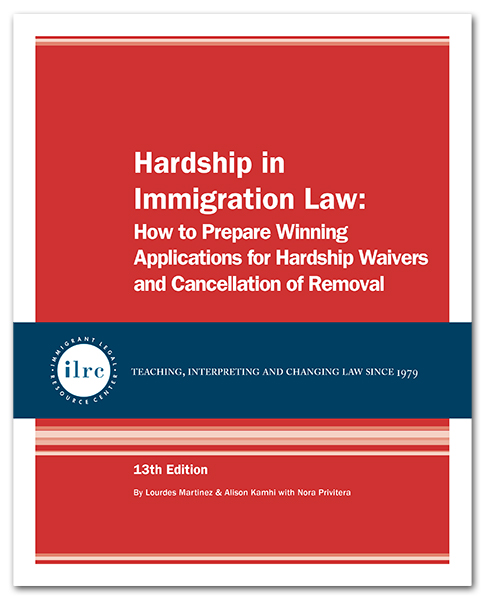
<p>The central focus of the curriculum is to help immigrants develop and refine their leadership and advocacy skills, and to teach them how to help others apply for citizenship. Using interactive teaching techniques, the curriculum is designed to give every student an opportunity to practice the skills taught during the training. Divided into 11 training units, the curriculum takes approximately 31 hours to teach, depending on the number of students and co-trainers.</p><p>The newest version of this manual includes an advanced leadership training curriculum. The advanced training includes a new addition to the curriculum entitled "Civic Action Projects" or CAPS. CAPS are small-group campaigns chosen, designed, and carried forth by lay leaders as a means of addressing problems affecting their communities. For example, a CAP might aim to improve the recreational services available for immigrant youth in the community, or it might aim to promote the hiring of more bilingual faculty and staff in the local school district. CAPs provide a forum where leaders can utilize their various skills developed in the basic training while they work on a campaign that addresses problems in their community.</p><div id="myEventWatcherDiv" style="display: none;"> </div>
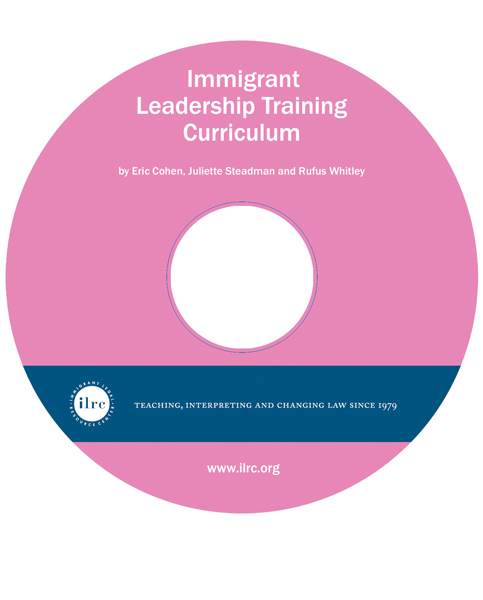
<p>Developing leadership skills among immigrant and refugee communities is more important now than ever. Since the attacks of September 11, 2001, there has been a widely reported increase in the hostilities, violence and discrimination against immigrant and refugee communities. Immigrant leaders, with the proper skills and tools, can help the community understand its rights, develop strategies for educating the public about who immigrants and refugees are and the benefits they bring to our society, and work to ensure that any new immigration legislation includes adequate provision of services.</p><p>This handbook chronicles the leadership development model explored in a joint initiative of the Lutheran Immigration & Refugee Services and ILRC. The model's core focuses on the relationship between community-based organizations that provide services to immigrants and the immigrant communities they serve. Seeking to enhance the effectiveness of this collaboration can yield new vitality because the uniting of established, experienced organizations with the energy, ideas, skills and concerns of immigrants and refugees can strengthen both the organizations and the communities they serve.</p><p>The curriculum in this manual employs interactive teaching techniques with the goal of helping dedicated community leaders develop and refine their leadership and advocacy skills, use such skills in their communities to work on civic issues, and build alliances with community-based organizations.</p><p>The handbook describes how to set up a leadership training, including ideas on ways to get funding for the training, how to implement a volunteer program at a community based organization, and how to build immigrant-led civic participation campaigns. Additionally, the handbook describes several immigrant led campaigns that community based organizations have successfully engaged in over the last several years.</p><p>This training curriculum is complete and ready to be used. You will find here almost all the materials that you will need for the entire training. The manual includes a combination of actual training units and other text designed to help the trainer succeed in promoting immigrant leadership training and civic participation initiatives. Now is the time to seize this Initiative!</p>
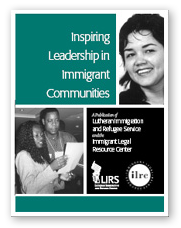
<p><strong>Naturalization and U.S. Citizenship: The Essential Legal Guide.</strong> Now in its 13th Edition, the ILRC continues to write the most accessible comprehensive guide on the naturalization process and citizenship. Consisting of 14 chapters and extensive appendices, this indispensable guide thoroughly addresses the entire process of representing a naturalization applicant from the initial client meeting through the oath of allegiance. You will find sample forms, Immigration Service memos, practice guides, and many other essential tools for both private attorneys and practitioners working with community-based organizations. This edition includes a detailed explanation of the nuances involved in determining whether a naturalization applicant has sufficient good moral character to qualify for naturalization, a clear and complete description of the myriad of ways in which an absence could affect one’s naturalization application, and an explanation of the newly released N-400 form and how to best complete it. Overall the reader will learn detailed eligibility requirements for naturalization and helpful suggestions on both procedural issues and ways to effectively work with naturalization clients. We discuss what to do if a naturalization application is denied and how to determine if a client may already be a U.S. citizen through either acquisition or derivation of citizenship. The guide has the most user-friendly group of charts on how to determine if someone gained U.S. citizenship through acquisition or derivation of citizenship in existence. The Essential Legal Guide covers valuable information on how to help applicants with disabilities apply for naturalization. One of the strengths of the Essential Legal Guide is that it is very easy to read and understand for lawyers and other community advocates, including paralegals, community and labor organizers, and teachers. With dozens of examples demonstrating the legal concepts and thousands of citations to the law, regulations, and court cases, the reader will be thoroughly prepared to do the legal research necessary to successfully support clients towards applying for and winning naturalization.</p>
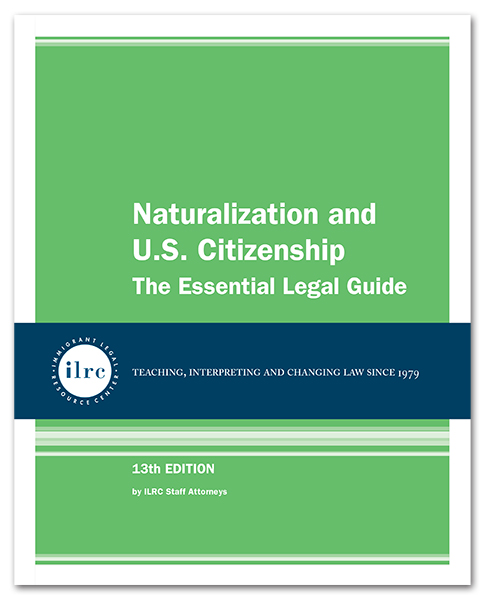
<p><strong>Remedies and Strategies for Permanent Resident Clients. </strong>Protect your permanent resident clients from being removed under a deportation or inadmissibility ground using the expert analysis and framework for representation contained in this manual. Designed as a “how to” manual, we provide clear, concise and detailed explanations of the grounds of removal permanent residents are most likely to face; when the grounds of inadmissibility and deportation do and don’t apply; how to argue that they don’t apply, and the immigration remedies available for each. We also discuss our tips for working with clients to elicit the evidence necessary to successfully defend their cases.</p><p>This manual contains detailed chapters on the grounds of deportability and inadmissibility, as well as the most common remedies for those charged with removability for crimes: LPR cancellation of removal (Chapter 4), former § 212(c) relief (Chapter 5), and relief under § 212(h) of the Immigration & Nationality Act (Chapter 6). It also contains a chapter devoted to the comparison of LPR cancellation of removal and § 212(h) relief (Chapter 7), and a summary of other, less common remedies for permanent resident clients (Chapter 8). Finally, it contains a separate chapter on detention, (Chapter 9) and a chapter on how to work with clients to obtain the best evidence in their cases (Chapter 10).</p><p>Throughout the manual we also emphasize that termination of removal proceedings is the best remedy for the permanent resident client. Therefore we present arguments that you can use to challenge the Notice to Appear and continually remind practitioners that whether or not a client has a claim to U.S. citizenship should never be ignored.</p><p> </p><p> </p>

<p>Immigrant children and youth may be eligible for special types of immigration relief available just for children, or they may be eligible for immigration relief in different ways than adults. In addition, separate procedures may and often do apply in the immigration process for children and youth. A new federal law enacted in December 2008, called the William Wilberforce Trafficking Victims Protection Reauthorization Act of 2008, further introduced important new protections for the treatment of unaccompanied minors in the immigration system.</p><p>This manual seeks to provide background and guidance on these protections, procedures, and immigration options. It has a special focus on Special Immigrant Juvenile Status, but also provides information on other immigration options for children and youth including: U Nonimmigrant Status, Violence Against Women Act protection, asylum, family-based immigration options, citizenship, and others. It also addresses specialized issues, such as working and representing child clients, immigration consequences of delinquency, and detention. The manual contains many useful items for practitioners, including sample screening intake forms, sample application forms, motions, court orders, and other papers that can be presented to the juvenile court, immigration court, and immigration authorities.</p><p>(Click <a href="/info-on-immigration-law/remedies-for-immigrant-children-and-youth">here</a> to link to more SIJS resources)</p>
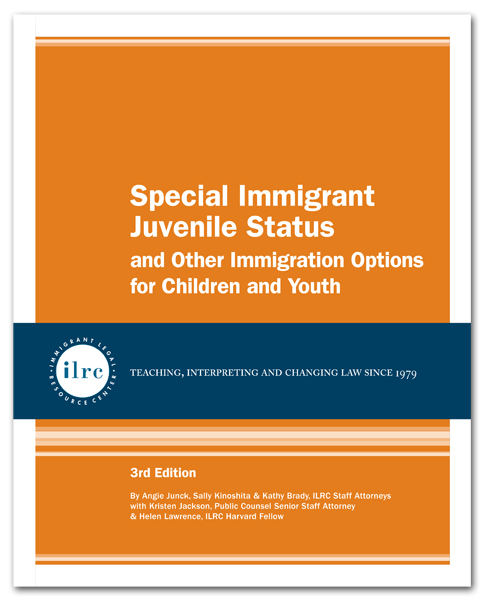
<p><em><strong>4th Edition now available - expanded content and samples!</strong></em></p><p><em>The U Visa: Obtaining Status for Immigrant Victims of Crime</em> will guide you through the entire process of handling an immigration case for a U visa applicant—from eligibility screening for U nonimmigrant status through adjustment of status to assisting eligible family members and helping U nonimmigrants travel. In addition to providing a thorough explanation of the requirements and application processes, this manual includes numerous practice pointers and sample materials to help you in handling your client’s case. These include sample checklists, cover letters, declarations, receipt notices and other correspondence you can expect to receive from USCIS, motions to submit to the immigration court, and more.</p><p>This fourth edition of The U Visa: Obtaining Status for Immigrant Victims of Crime manual has been completely updated and the new features include:</p><ul><li>Detailed updates on the new U conditional approval and deferred action policies and procedures</li><li>Updates and flowcharts for assisting U nonimmigrant clients with travel issues and consular processing</li><li>New information on identifying and helping workplace victims of crime and working with the Department of Labor, EEOC or California DFEH for certification</li><li>Updated information and developments related to U adjustment of status applications</li><li>The latest information on addressing removal issues including prosecutorial discretion, issues that can appealed or waived and using U nonimmigrant status as a relief from removal or a means to terminate proceedings</li><li>Many more sample materials including applications and declarations for adjustment applications, consular processing, and outreach and explanatory materials for clients.</li></ul><p>For more details on specific chapters, go to the Sample Content tab and click Chapter Descriptions.</p>
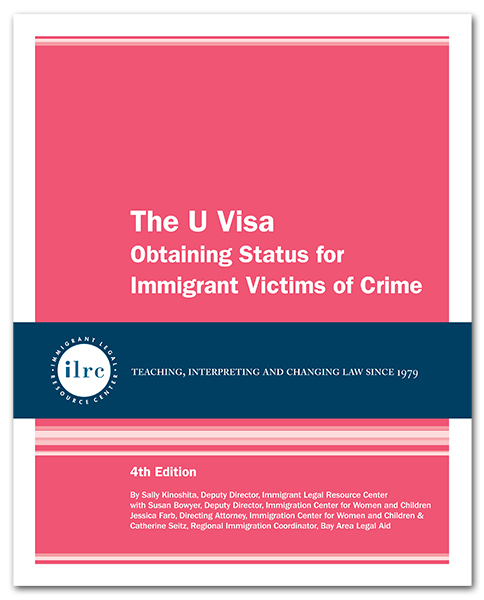
The VAWA Manual: Immigration Relief for Abused Immigrants is a completely revised edition of our popular, comprehensive guide for advocates working with immigrant survivors of domestic violence.
Consisting of 11 chapters, this manual includes in-depth information on the following critical areas:
- VAWA self-petitioning requirements and process
- Adjustment of status
- Inadmissibility grounds and waivers
- Removal proceedings and motions to reopen VAWA
- VAWA cancellation of removal
- Conditional permanent residency
- Consular processing, and more
Also featured are practical tips for working with immigrant survivors of domestic violence, assembling and documenting a strong VAWA self-petition, and extensive appendices of CIS policy guidance, sample applications, fee waiver requests, declarations, and more.
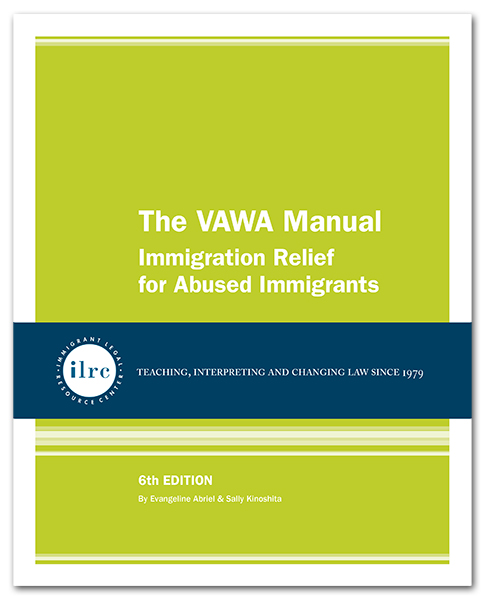
<p><strong><em>The U Visa: Obtaining Status for Immigrant Victims of Crime</em></strong> will guide you through the entire process of handling an immigration case for a U visa applicant – from eligibility screening for U nonimmigrant status to communicating about the wait list and deferred action through adjustment of status to assisting eligible family members and helping U nonimmigrants travel. In addition to providing a thorough explanation of the requirements and application processes, this manual includes numerous practice pointers and sample materials to help you in handling your client’s case. These include sample checklists, cover letters, declarations, receipt notices and other correspondence you can expect to receive from USCIS, motions to submit to the immigration court, and more.</p><p>This fifth edition of <em>The U Visa: Obtaining Status for Immigrant Victims of Crime</em> is completely updated and the new features include:</p><ul><li>Detailed updates on the new U wait list and deferred action policies and procedures</li><li>Updates and flowcharts for assisting U nonimmigrant clients with travel issues, parole and consular processing</li><li>Information on identifying and helping workplace victims of crime and working with the Department of Labor, EEOC or California DFEH for certification</li><li>Updated information and developments related to U adjustment of status applications</li><li>The latest information on addressing removal issues including prosecutorial discretion, issues that can appealed or waived and using U nonimmigrant status as a relief from removal or a means to terminate proceedings</li><li>Many more sample materials including applications and declarations for adjustment applications, consular processing, and outreach and explanatory materials for clients</li><li>Expanded sections and samples for assisting family members through the I-929 petition process</li></ul>
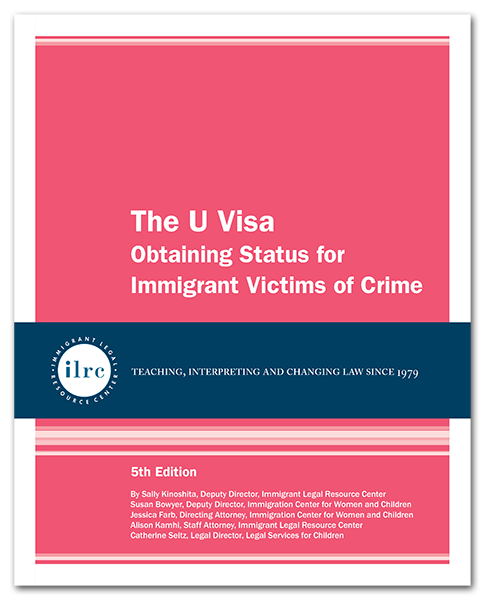
<p>This handbook contains lessons learned and promising practice tips in the context of a team-based approach to serving human trafficking survivors. It is based on years of experience representing survivors of human trafficking acquired by the authors, national experts Lynette M. Parker, Cindy Liou, and Ivy Lee. These lessons and tips focus on the experiences of the San Francisco Bay region, but may have applicability to other regions of the United States. </p><p>The objective of this publication is to assist advocates for survivors of human trafficking, attorneys and non-attorneys, who are critical to the successful stabilization of those who have been victimized by human trafficking. Written primarily for immigration legal service providers and private attorneys, the comprehensive analysis of how to approach a trafficking case will also be valuable to case managers, health care providers, and law enforcement agencies.</p><p>The objective of this handbook is to provide a roadmap based on real cases, including the mistakes and lessons learned and promising practices, that will hopefully save other advocates time and energy as you continue to build more effective capacity for assisting trafficked persons. The roadmap includes an overview of the basics, as well as fundamentals of trafficking cases for a team-based model to serve survivors of trafficking. This publication includes:</p><ul><li>Tips for identifying a potential victim of human trafficking</li><li>How to address the most common questions about a trafficking situation</li><li>How to deal with the practical challenges of a trafficking case</li><li>Diverse options for relief that may be available to your client</li><li>How to support survivors and service providers of a trafficking case</li></ul><p>In this second edition, the authors also include advanced topics for practitioners, such as more in-depth practice pointers regarding civil litigation, updates on effectively wielding the visa relief available to survivors, and lessons learned in collaborative work in the years since the first edition.</p><p>The authors have been working and writing on behalf of trafficking survivors for more than 10 years. Their extensive experience makes this handbook particularly thoughtful, relevant, and comprehensive.</p>
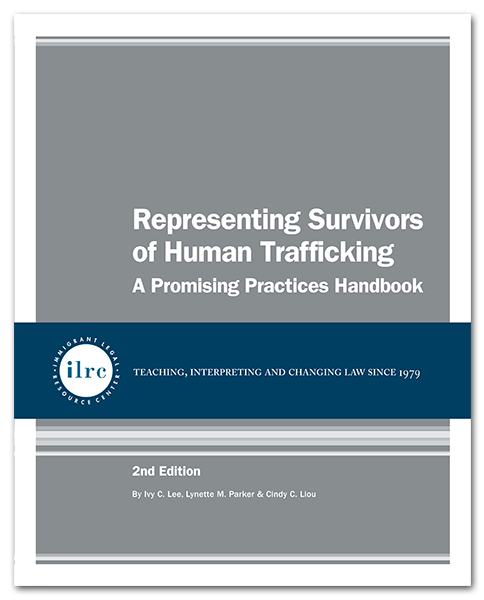
<p>The second edition of <em>DACA: The Essential Legal Guide</em> is a practice-oriented overview of Deferred Action for Childhood Arrivals (DACA). This manual is based on more than two decades of community education, outreach, training and technical assistance on issues impacting immigrant youth. We have also leveraged new information and experience gleaned over the course of the DACA program thus far.</p><p>Comprehensive and user-friendly, this manual consists of 11 easy-to-read chapters and appendices that cover:</p><ul><li>DACA eligibility requirements</li><li>Entire process for representing a DACA applicant from initial client meeting to closing of your client’s case</li><li>Detailed discussion of the criminal bars to DACA</li><li>Tips on how to help clients obtain the necessary documentation to apply</li><li>Best practices on how to complete all of the immigration forms</li><li>Helpful suggestions on procedural issues and ways to effectively work with DACA applicants</li><li>Guidance on other immigration law risks or benefits that may affect DACA applicants </li><li>Sample documents, forms, practice advisories, helpful guides, numerous examples demonstrating legal concepts, and several other essential tools for both private attorneys and nonprofit practitioners</li></ul><p>New updates to this edition include:</p><ul><li>Clarifications and tips on DACA eligibility, particularly meeting educational requirements and evading the criminal bars</li><li>New appendices and sample materials such as new policy guidance from USCIS, sample documents for applications, and resources on how to organize DACA workshops</li><li>A new chapter on what applicants can do after they receive DACA, including obtaining a social security number and traveling abroad under Advance Parole</li></ul><p>For additional information and resources:</p><p>Visit our Deferred Action for Childhood Arrivals (DACA) <a href="/info-on-immigration-law/deferred-action-for-childhood-arrivals" target="_blank">web page</a>.<br />Subscribe to the DACAexperts listserv by sending an email to dacaexperts-subscribe@yahoo.com.</p>
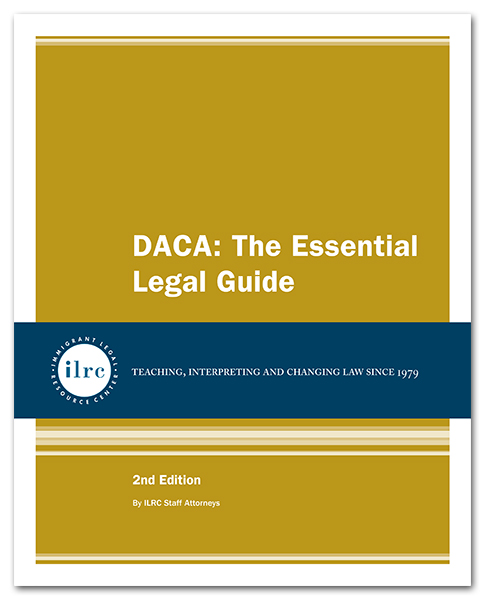
<p>Immigrant children and youth may be eligible for special types of immigration relief available just for children or they may be eligible for immigration relief in different ways than adults. In addition, separate procedures may and often do apply in the immigration process for children and youth. A federal law enacted in December 2008, called the William Wilberforce Trafficking Victims Protection Reauthorization Act of 2008 (TVPRA), introduced important protections for the treatment of unaccompanied minors in the immigration system, many of which have continued to be clarified in recent years. This manual is an essential guide for those representing the increased number of unaccompanied minors who have migrated to the United States in recent years, as well as those representing immigrant youth who were brought to the United States at a young age and know no other home.</p><p>In particular, this manual seeks to provide background and guidance on the protections, procedures, and immigration options for immigrant children, including unaccompanied minors under the TVPRA. It has a special focus on Special Immigrant Juvenile Status (“SIJS”), with an in-depth discussion of the legal requirements for SIJS eligibility, including “one-parent” SIJS cases, and step-by-step guidance for representing SIJS-eligible youth in both affirmative and defensive applications. The manual also provides information on other immigration options for children and youth including: U Nonimmigrant Status, T Nonimmigrant Status, Violence Against Women Act protection, asylum (with a special discussion of unaccompanied minor asylum cases and evolving social group claims), family-based immigration options, citizenship, and others. It also addresses specialized issues such as working with and representing child clients, immigration consequences of delinquency and drug trafficking or gang involvement, and the immigration detention system for youth. The manual contains many useful items for practitioners, including sample screening forms, SIJS and other applications, state court motions, immigration court motions, court orders and other resources for helping advocates and their clients understand and interact with the juvenile court, immigration court, and immigration authorities.</p><p><strong>New in this edition</strong></p><ul><li>Updated discussion on working with and representing children and youth</li><li>Updates on court processes and options for unaccompanied minors, including expedited dockets, U.S. juvenile immigration detention system, and new</li><li>in-country refugee and parole program for certain youth in Central America</li><li>Expanded and updated discussion of “one-parent” SIJS cases, including an overview of the state law addressing these claims and practice tips</li><li>Expanded discussion of the grounds of inadmissibility as they most commonly apply to youth, including special focus on the emerging defenses to the inadmissibility ground for “reason to believe” that someone is a drug trafficker</li><li>New chapter on immigration relief for victims of trafficking (T visas)</li><li>Revised chapter on “other forms of immigration relief” for immigrant youth, including Deferred Action for Childhood Arrivals (DACA) and Deferred Action for Parents of Americans and Lawful Permanent Residents (DAPA)</li></ul>
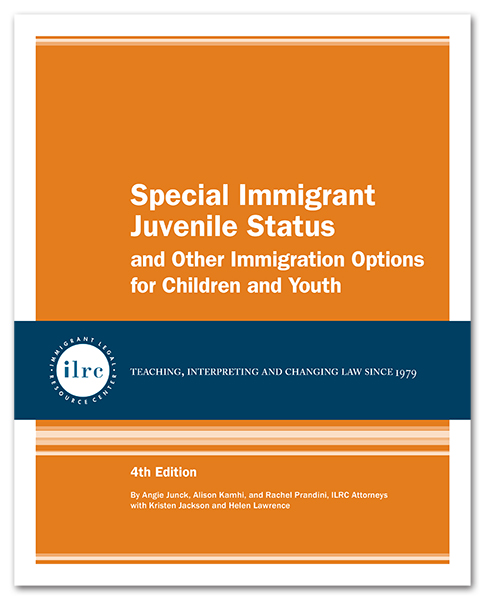
<p>This manual is ideal for immigration practitioners interested in developing their cultural competency and legal expertise in the area of lesbian, gay, bisexual, transgender, queer (LGBTQ) immigration. Confronted with the same cumbersome immigration system as other immigrants, individuals who identify as LGBTQ often face unique challenges. Understanding how an LGBTQ identity influences an individual’s immigration experience is crucial to ensuring that LGBTQ immigrants receive culturally competent services that adequately meet their needs and ultimately help them access the protections and benefits to which they have a right under federal immigration laws. This manual is intended to serve as a tool for legal representatives and other service providers who represent LGBTQ individuals in immigration matters.</p>
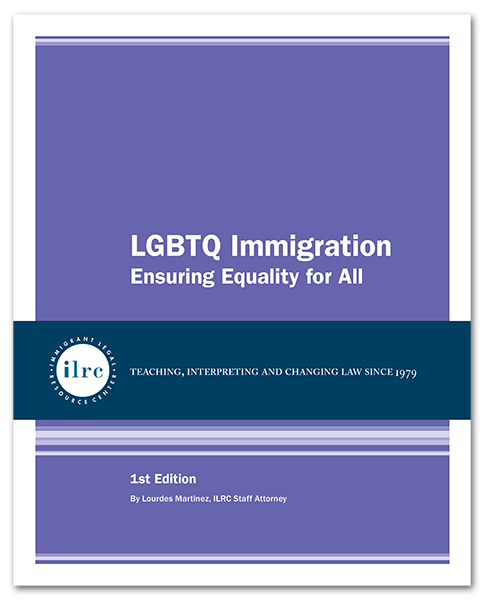
<p>One thing that is abundantly clear—immigrants need representation in immigration court. Most immigrants face removal proceedings without an attorney or authorized representative, and the outcomes with and without a representative are grossly disparate. With this publication, we hope to build the capacity of immigration practitioners to assist individuals in immigration court proceedings to provide more immigrants with a meaningful chance at justice.</p><p>This first edition of <em>Removal Defense: Defending Immigrants in Immigration Court</em> is a quick reference to key issues in removal defense, with a focus on the practical questions that aren’t easily answered by combing the regulations and case law. The appendices include many helpful samples which provide a fuller understanding of what court practice looks like.</p><p>This resource covers an overview of immigration proceedings, the grounds of inadmissibility and deportability, pleading to the Notice to Appear, trial practice tips, getting your client released on bond including a discussion of mandatory detention, and a look at common forms of relief from removal, including cancellation of removal for both lawful permanent residents and non-residents, as well as asylum.</p>
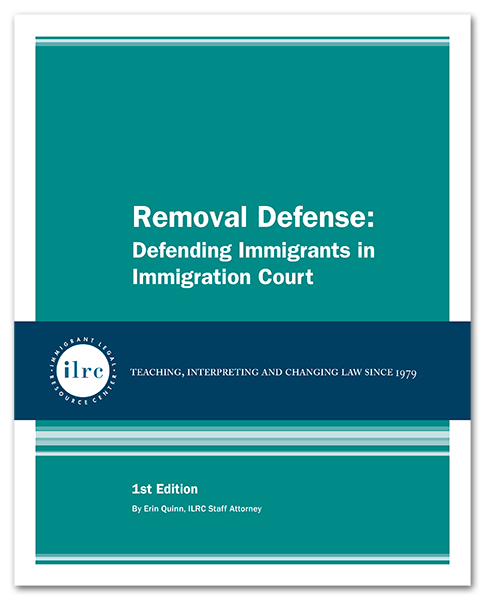
<p>The third edition of this comprehensive survey of the basic elements of asylum law now includes a thorough overview of asylum procedure, complete with practice tips for preparing asylum claims for unaccompanied minors. This publication is intended for advocates who want to understand the law and are new to representing asylum clients, as well as for seasoned practitioners needing a thorough review of current standards.</p><p>Combining up-to-date case law, cutting edge legal arguments on currently developing issues and decades of expertise from accomplished practitioners who have successfully represented clients through the years, <em>Essentials of Asylum Law</em> offers an expansive explanation of the legal theories and rules underpinning current asylum claims. The manual explores each of the legal elements of an asylum claim, beginning with the definition of persecution and the requirements to demonstrate a “well-founded fear” of persecution. An extensive discussion of the five enumerated grounds follows, including a detailed overview of the <em>nexus </em>requirement and the most cutting edge particular social groups. The legal bars to asylum are explored at length, as well as the alternative protections to asylum—Withholding of Removal and protection under the Convention Against Torture—for those that do not qualify for asylum. Finally, the third edition of this publication includes a thorough overview of the procedural steps involved in filing an asylum claim, with new sections describing the process for unaccompanied minors and special considerations for working with children. It explores both the <em>affirmative </em>application process through a claim filed with the U.S. Citizenship and Immigration Services and the <em>defensive </em>application process in immigration court.</p>
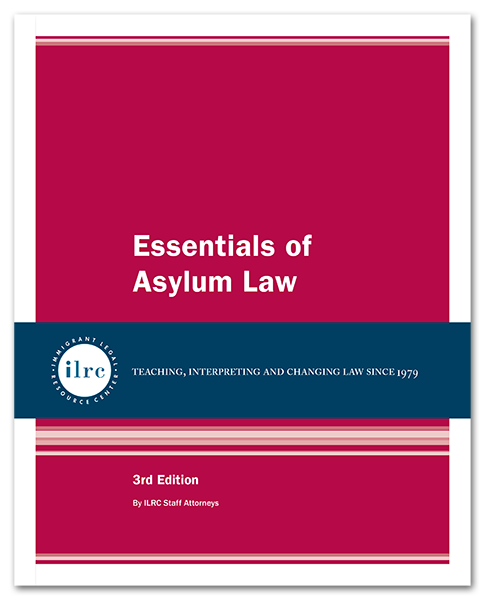
<p>The new landscape of immigration enforcement involves ICE agents arresting families in their homes and expansive cooperation with local and state law enforcement. Questions around ICE detainers and the authority of local law enforcement to be involved in immigration enforcement are swirling, while ICE raids on immigrant families continue. All these aggressive immigration enforcement actions make understanding the fundamental rights of immigrants in these situations more important than ever. <em>Motions to Suppress: Protecting the Constitutional Rights of Immigrants in Removal Proceedings</em> is an essential reference book for immigration practitioners. Practical and informative, it covers the relevant sources of law needed to exclude unlawfully obtained evidence in immigration court, provides sample motions to suppress, and addresses the rights of detained immigrants.</p><p>This manual includes:</p><ul><li>Clear explanations on the law and theory needed to suppress evidence in immigration court, including the constitutional, statutory and regulatory rights of immigrants at work, at home or in public places.</li><li>Step-by-step guidance on the procedure for filing and litigating a motion to suppress, including an outline of the chronological steps for preparing a motion to suppress, models for client intake, and sample motions to suppress to illustrate the arguments to preserve and assert your clients’ rights.</li><li>An introduction to other litigation options to challenge the actions of those involved in immigration enforcement, such as habeas¸ and claims under the Civil Rights Act of 1871, 42 U.S.C. § 1983, and <em>Bivens</em> actions.</li><li>A chapter dedicated to fighting detainers issued by DHS to hold immigrants in local custody awaiting pick-up by ICE.</li><li>Discussion of the rights of immigrants in detention and administrative complaint options.</li><li>And many samples and resources for litigation and motions!</li></ul>
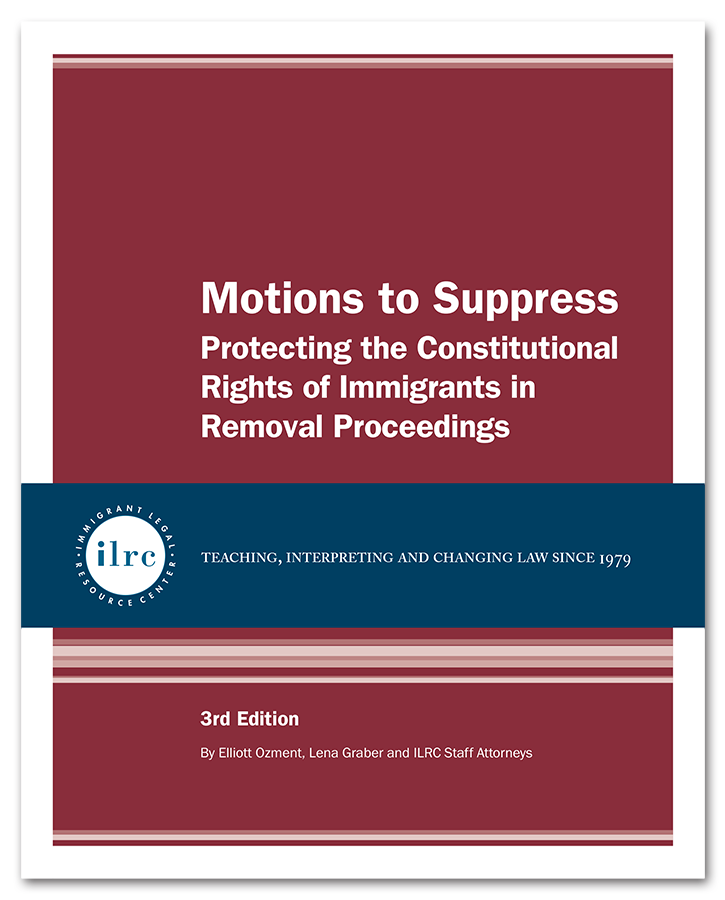
<p><em>Inadmissibility & Deportability</em> is a practical and easy to use manual for beginning immigration attorneys, paralegals, non-profit community based organizations and other advocates on the grounds of inadmissibility, deportability and waivers. Written in plain English and filled with explanatory examples, charts and practical suggestions, this guide is a go-to resource to assess whether your client is subject to the grounds of removal. This manual covers all common grounds of inadmissibility and deportability and features a chapter dedicated to explaining how to assess criminal issues and the grounds of removability.</p><p><strong>Highlights</strong></p><ul><li>Easy-to-use reference for the most common grounds of inadmissibility and deportability</li><li>Chapter dedicated to unlawful presence and removal grounds of inadmissibility</li><li>Important new updates to the criminal grounds of admissibility and deportability</li><li>Up-to-date discussion of the categorical approach in immigration proceedings, with consideration of the Supreme Court holdings in <em>Moncrieffe v. Holder</em> and <em>Descamps v. United States</em></li><li>Includes a sample waiver argument, charts, tips, samples and practical suggestions</li></ul>
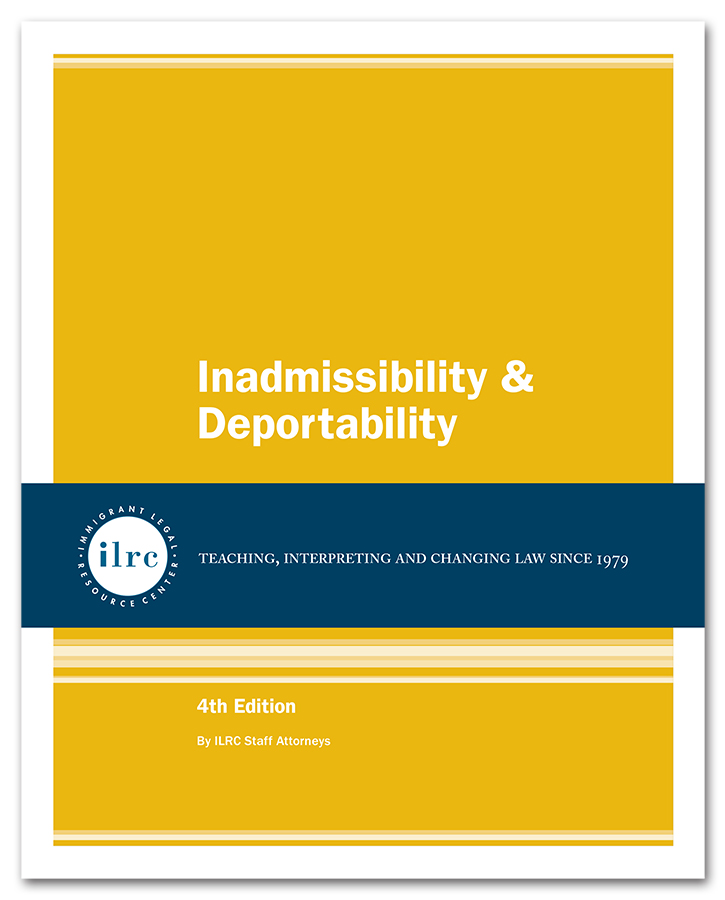
<p>At this seminar, we will cover cutting-edge, hot topics in U visa and VAWA cases, including possible U visa age out issues, U adjustment of status, consular processing of U visas, as well as overcoming inadmissibility issues and prior removals for both U visa and VAWA cases. We will discuss, at length, when to pursue a VAWA self-petition versus VAWA cancellation versus a U visa, and we will also analyze complicated scenarios to determine the best strategies in pursuing a U visa versus VAWA.<br /><br /><strong>Presenters:</strong><br /><strong>Sally Kinoshita</strong>, ILRC Deputy Director & Staff Attorney<br />Sally is the principal author of the ILRC publication entitled, The U Visa: Obtaining Immigration Status for Immigrant Victims of Crime and the co-author of the ILRC publications, The VAWA Manual: Immigration Relief for Abused Immigrants; Special Immigrant Juvenile Status for Children Under Juvenile Court Jurisdiction and Immigration Benchbook for Juvenile and Family Court Judges.<br /><br /><strong>Alisa Daubenspeck</strong>, Central American Resource Center (CARECEN)<br /><br /><strong>Cynthia Lucas</strong>, Immigration Center for Women and Children<br /><br /><br /><strong><em>I am not a member of the California State Bar. Will I receive CLE credit for participating in your seminars & webinars?</em></strong><br />We will provide a Uniform Certificate of Attendance after the session, which you can submit to your state bar. Please contact your state bar for details on whether or not credit is acceptable.</p>
<p><b>This training is a four-session course:</b></p><p>Thursdays, March 3 & 10, 1:00 pm – 5:30 pm</p><p>Fridays, March 4 & 11, 9:00 am – 1:00 pm</p><p>*On March 3 (the first session date), sign-in for the seminar starts at 12:30 pm*</p><p>Designed for an attorney who wants to boost his or her knowledge and confidence, this course covers the fundamental concepts and elements of immigration law and procedures. The program will cover all major themes of immigration law, including constitutional issues, grounds of inadmissibility and deportability and related procedures, waivers and relief from removal, the various immigration preference categories, nonimmigrant classes, refugees and asylum, adjustment of status, administrative appeals and judicial review, and the acquisition of American citizenship.<br /><br /><b>NOTE:</b> This seminar is limited to attorneys and BIA Level 2 Accredited Representatives. Maximum capacity of 20 registrants on a first-come, first-served basis of when we receive your registration with full payment. If you are interested in this seminar, we also recommend our newly updated edition of <b><i><a href="https://www.ilrc.org/publications/detail.php?id=59" target="">A Guide for Immigration Advocates</a></i></b></p><p><b>Deadline to Register: </b>2/23/11</p><p><b>Presenter: </b><b>Don Ungar, Of Counsel to Simmons & Ungar and the ILRC</b></p><p>With more than 40 years of immigration law experience, Don has litigated numerous cases before the Board of Immigration Appeals, the federal district courts, courts of appeal and the United States Supreme Court. He was the recipient of the first Jack Wasserman Award for excellence in litigation by the American Immigration Lawyers Association, as well as the Phillip Burton Immigration and Civil Rights Award.</p>
<p>At this seminar, we will cover cutting-edge, hot topics in U visa and VAWA cases, including possible U visa age out issues, U adjustment of status, consular processing of U visas, as well as overcoming inadmissibility issues and prior removals for both U visa and VAWA cases. We will discuss, at length, when to pursue a VAWA self-petition versus VAWA cancellation versus a U visa, and we will also analyze complicated scenarios to determine the best strategies in pursuing a U visa versus VAWA.<br /><br /><strong>Presenters:</strong><br /><b>Sally Kinoshita</b>, ILRC Deputy Director & Staff Attorney<br />Sally is the principal author of the ILRC publication entitled, <a href="/store/publications/the-u-visa"><i><b>The U Visa: Obtaining Immigration Status for Immigrant Victims of Crime</b></i></a> and the co-author of the ILRC publications, <a href="/store/publications/the-vawa-manual"><i><b>The VAWA Manual: Immigration Relief for Abused Immigrants</b></i></a>; <i>Special Immigrant Juvenile Status for Children Under Juvenile Court Jurisdiction</i> and <i>Immigration Benchbook for Juvenile and Family Court Judges</i>.<br /><br /><strong>Evangeline Abriel</strong>, Santa Clara University, School of Law<br />Evangeline is the Director of Legal Analysis, Research, and Writing at Santa Clara University, School of Law and a consultant to the Catholic Legal Immigration Network, Inc. (CLINIC). She is the co-author of ILRC's The VAWA Manual: Immigration Relief for Abused Immigrants, and the co-author of A Guide for Legal Advocates Providing Services to Victims of Human Trafficking. In addition, she teaches courses in the area of immigration law and writes and speaks frequently on immigration relief for victims of abuse and crime.<br /><br /><strong>Susan Bowyer</strong>, San Francisco Director of Immigration Center for Women and Children and Director of Immigrant Survivors’ Legal Aid<br />Susan has been the Managing Attorney at IIBA, an attorney and echoing green fellow at the Immigrant Legal Resource Center, and the Acting Director at the Center on Race, Poverty and the Environment. For the past decade, she has provided immigration legal services for low income immigrants, and she has special expertise in immigration applications for survivors of domestic violence and other crimes. In addition, she has presented dozens of trainings on immigration relief for battered immigrants, including presentations at the 2008 California and 2009 National AILA Conferences.<br /><br /><strong>Catherine Ward-Seitz</strong>, Regional Immigration Coordinator for Bay Area Legal Aid<br />Catherine has been working in the field of immigration law since 1990, starting out as legal assistant and then a BIA Accredited Representative before her admission to the bar in December of 2001. Before joining Bay Area Legal Aid as Regional Immigration Coordinator in July of 2009, she worked at Canal Alliance, the International Institute of the East Bay, and the private immigration law firm of Simmons & Ungar.<br /><br /><br /><em><strong>I am not a member of the California State Bar. Will I receive CLE credit for participating in your seminars & webinars?</strong></em><br />We will provide a Uniform Certificate of Attendance after the session, which you can submit to your state bar. Please contact your state bar for details on whether or not credit is acceptable.</p>
